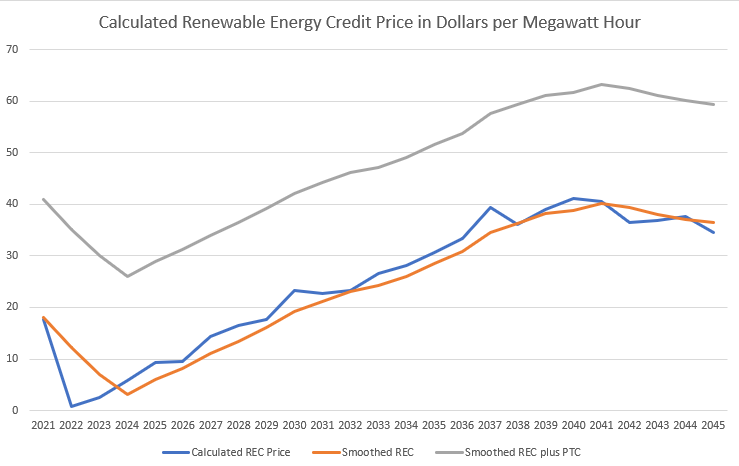The source policy data is used similarly but slightly differently in each of the Council’s power system models. Due to the differences of model fidelity and focus, each model requires slightly different forms of the same source information. The interpretation of these policies is specifically important when considering the attributes of certain resources within strategies in the power system. Thus, the implementation in the models that simulated the costs of capital investments, Regional Portfolio Model and AURORA, are discussed below.
Regional Portfolio Model
The methodology for converting the source forecast into information for the Regional Portfolio Model was discussed in the System Analysis Advisory Committee. The model had to be enhanced to be able to account for clean and RPS forecasts within the region.
The Renewable Energy Credit forecast developed in AURORA, as described below, is used in conjunction with the wholesale electricity market price forecast to translate the effect on resource decisions in the region from external to the region policies.
Redeveloped GENESYS
While the none of the adequacy work in the redeveloped GENESYS focuses on building resources to meet policies, the operational decision to curtail is affected by those policies. Thus the expected cost of curtailment for renewable resources is applied using the average value from the Renewable Energy Credit price forecast discussed below.
AURORA
The methodology for converting the source forecast into information for AURORA discussed in the System Analysis Advisory Committee. There were a couple key decisions associated with building out resources to meet these policies and also maintain an adequate and operational system.
The first modeling technique was to have peak capability[1] for Northwest hydro resources be associated with a low hydro year, but have the buildout reference the energy associated with an average hydro condition. This makes sure that Northwest hydro is still given credit for providing a considerable amount more clean energy from year to year than it does in its worse year, while acknowledging that from an adequacy perspective it is difficult to account on a particular amount of hydro from year to year based on runoff.
The massive increase in cumulative WECC clean policies and Renewable Portfolio Standards created challenges for the capital expansion module to build and operate renewable and clean resources appropriately. The second modeling technique to more dynamically reflect the foregone value of renewable or clean generation[2] being used to meet a policy was to use AURORA to create a Renewable Energy Credit (REC) forecast as can be seen below. There may be another mechanism to account for clean energy resources, but the REC forecasted price is used as the best available proxy cost of curtailment. The same REC price forecast was used in the baseline and all scenarios.
REC Forecast from AURORA

[1] Called peak credit in AURORA. Indicates how much credit a particular resource should get when the model considers how many resources to build for adequacy.
[2] The foregone value of the generation from renewable generation can also include the production tax credit (PTC), not just a renewable energy credit. This is only relevant for existing wind resources in Council analysis.



